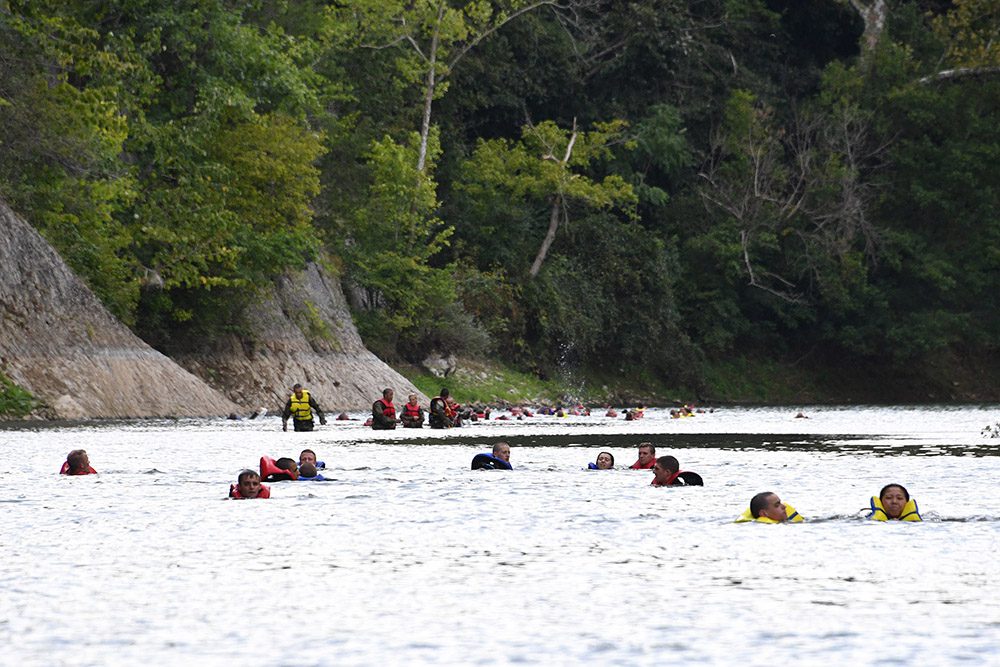River Swim Portion of Rat Crucible Goes On

Rats swim and wade in some places in the Maury River during Rat Crucible Aug. 25, 2019. The previous water line is visible on the cliffs. VMI photo by H. Lockwood McLaughlin.

Rats swim and wade in some places in the Maury River during Rat Crucible Aug. 25, 2019. The previous water line is visible on the cliffs. VMI photo by H. Lockwood McLaughlin.
Cadets and parents returning to Lexington this August likely noticed a big change if they came in via the Veterans’ Memorial Bridge at East Lexington – the concrete dam spanning the Maury River is gone. Thankfully, VMI’s use of the river for deep-water training is continuing, although with some minor adjustments.
The century-old dam, which had created an impoundment stretching a mile or more upriver, was removed at the end of May, resulting in a marked drop-off in the water level upstream.
Prior to the dam’s removal, new cadets participating in Rat Crucible, a series of intense physical activities held on the Sunday following Matriculation Week, would don life jackets before jumping into the river and then floating or swimming downstream. This year, during the Aug. 25 Crucible, new cadets largely followed the same procedure, but they waded instead of jumped into the water.
Members of the commandant’s office staff had done a safety test beforehand.
In midsummer, Lt. Col. Todd Pegg ’92, deputy commandant for operations, and Capt. Isaac Slone, facility director, put on the same gear that new cadets wear and then took a reconnaissance trip on the Maury. After finding a place to wade into the water, the duo then floated downstream where they could, and walked through the water when it became too shallow.
“There’s one section of about 30 meters in the middle that’s about knee or thigh high,” Pegg reported in early August. “So when the rats get to that section, they’ll stand up and wade. Then, they’re go back to floating downstream.”
Pegg explained that the river swim portion of Rat Crucible isn’t actually about swimming per se – and many incoming rats have never learned to swim, thus the life jacket requirement. “It’s a physical, conquer-your-fears type of thing,” he commented.
The plunge into the river is also meant as a very intentional cool down during August temperatures that are typically in the 80s, if not hotter.
“The river is heat stress management for us,” said Pegg. “Putting them in the river for a double rotation really reduces our heat casualties and heat stress. … We’re excited that the Crucible can still happen, because that’s a big deal.”
The water level drop-off following the dam removal has, though, put any deep-water jumps on hold, at least temporarily. Up until two years ago, Rat Challenge, a program designed by the physical education department to bolster rats’ physical fitness and class unity, included a platform from which new cadets jumped into the Maury.
Slone explained that while there are some spots of the river where the water is still deep enough for cadets to jump safely, there are no access points in those areas, and doing the type of work necessary to create riverbank access points may require a permit from the Army Corps of Engineers. As of early August, Slone was waiting to hear from Corps of Engineers representatives about scheduling a site visit.
Ultimately, though, he’d like to make deep water jumping an indoor sport, once VMI’s aquatics center, soon to be built adjacent to the Corps Physical Training Facility, is completed. In years past, he explained, he’d be the first one in during river jumps, making sure the plunge was safe for cadets.
“With the new aquatics facility … I’m hoping for an opportunity to move it in there, where I know exactly what’s underneath them,” Slone commented.